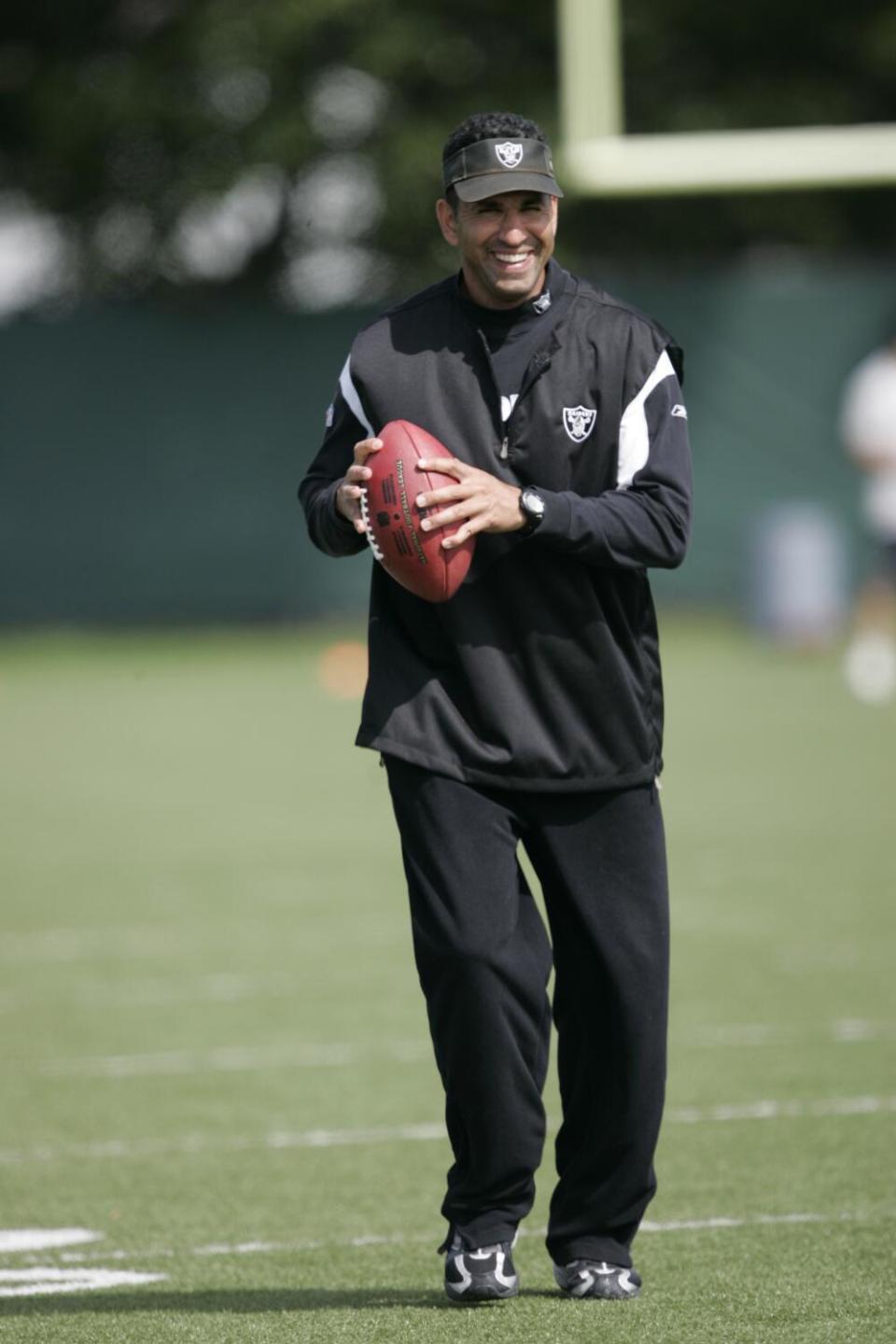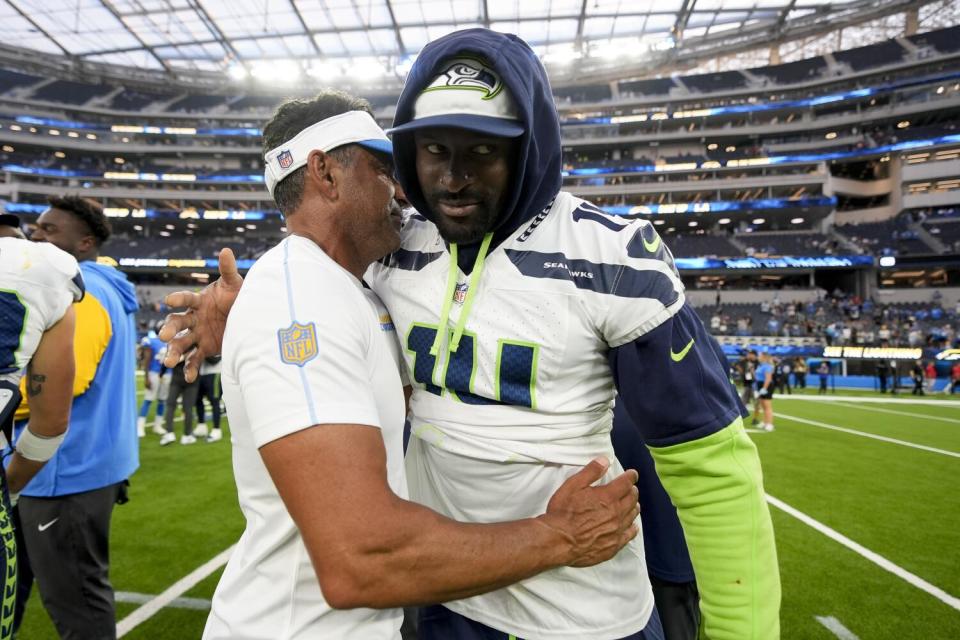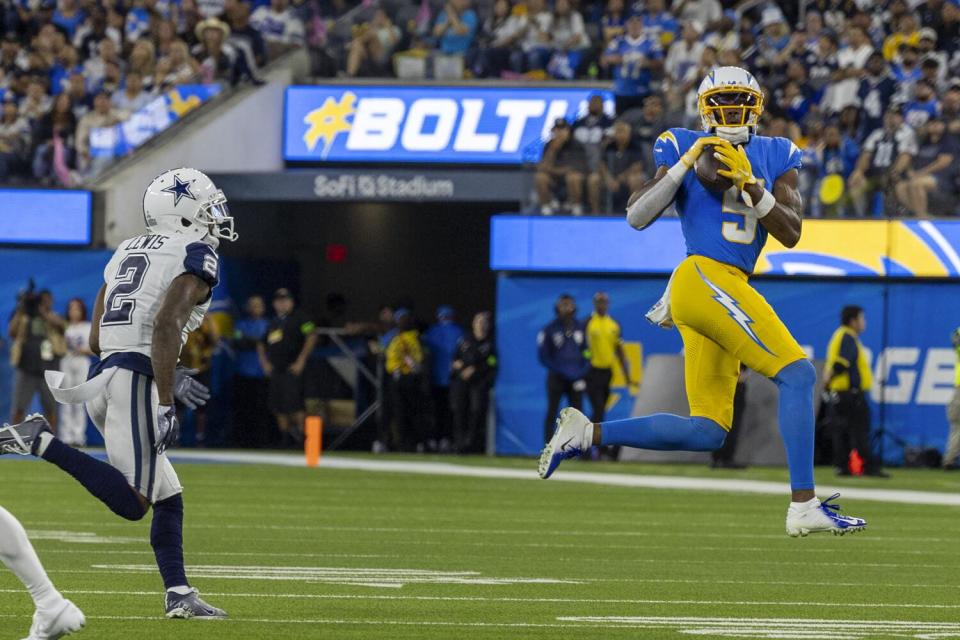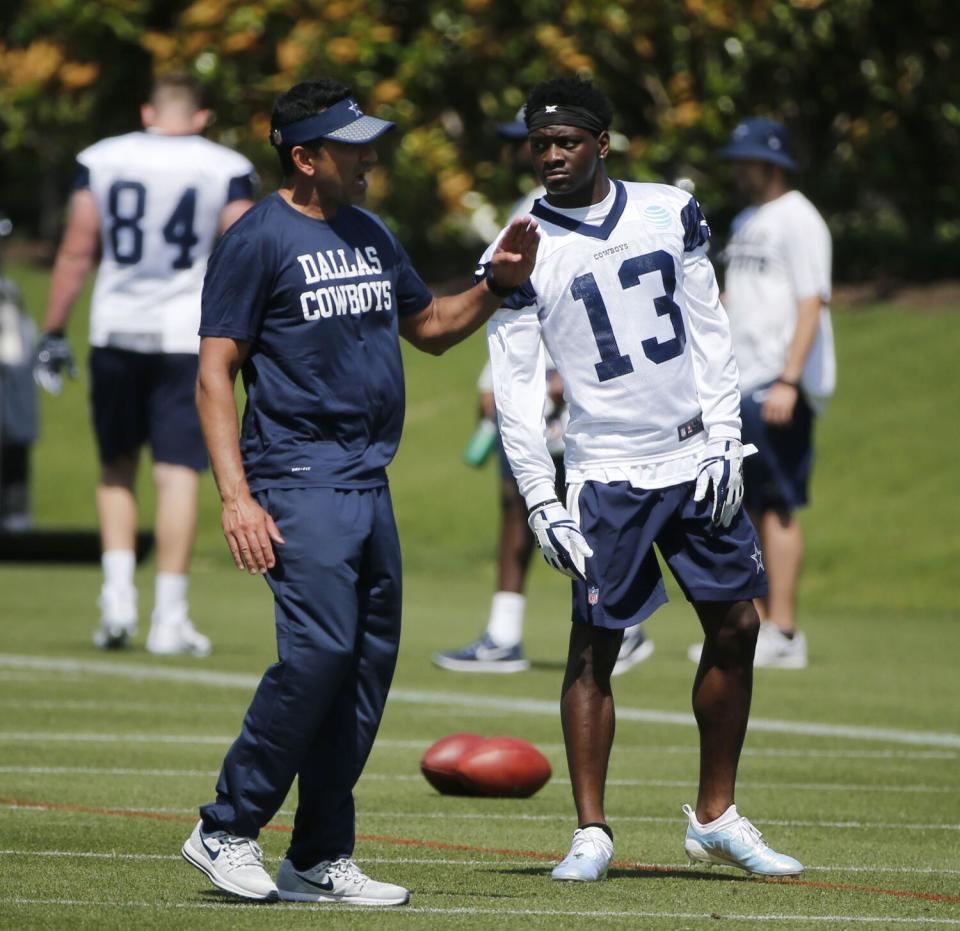


It’s too dramatic to suggest Sanjay Lal has to mold a clump of clay into a masterpiece, but as receivers coach for the Chargers, he’s facing a significant challenge.
The team has talent at the position, and certainly has invested draft picks, but in most cases those players are either untested or underperforming. On the other end of those passes is quarterback Justin Herbert, who has elite talent but has yet to achieve elite results, with nary a playoff victory to his name.
“I won’t say it’s been easy to this point,” Lal said recently. “But for the first time I feel like we’re on the right track. In fact, today I said, ‘No one knows who the eff we are.’ If we do things the way we’re coaching, with the juice, the sound technicians we’re becoming, the fight in the run game you’ll see … we don’t look like other teams.”
Jim Harbaugh and his coaching staff are out to make a change, and Lal — whose personal football odyssey is one of stubborn resolve — is an integral part of that effort.
First, the details. The Chargers’ two top receivers from recent years are now elsewhere. Keenan Allen left for the Chicago Bears, and Mike Williams is with the New York Jets. That leaves a crew that includes Joshua Palmer and Quentin Johnston, both big, young and promising but looking to make their mark on the NFL.
“If I find that trigger for each guy, then the group collectively is going to be a good one.”
Sanjay Lal, Chargers receivers coach on his young, untested group
The 6-foot-4 Johnston was the team’s first-round pick last year, yet the player who answers to “Q” remains a glaring question mark for the franchise. The standout from Texas Christian made some plays as a rookie but was better known for his unreliable hands.
The Chargers liked Georgia receiver Ladd McConkey enough to trade up this spring and draft him near the top of the second round. They added former second-round pick DJ Chark, who bounced from Jacksonville to Detroit to Carolina, and used a seventh-round pick on USC’s Brenden Rice, son of Hall of Fame receiver Jerry Rice.
Unquestionably, there’s talent in the building. Now it’s on those players and their coaches to turn that into plays on the field.
For Lal, the task is making the appropriate tweaks to help fine-tune each receiver.
“If I find that trigger for each guy, then the group collectively is going to be a good one,” he said. “But it’s not going to be that we walk out there to the Raiders [in the Sept. 8 opener] and we’re a finished product. There’s going to be ups and downs, and the trajectory just has to be up through the whole season. And if that’s the case we’ve done a good job.”
For inspiration, Lal can draw on his relentless determination, the way he hung on to his football dreams the way a dog hangs on to a sock.
He was born in London in 1969 to parents who had emigrated from India in search of a better life. His father worked for the world division of Electronic Data Systems, founded by technology pioneer and onetime presidential candidate Ross Perot. That had the Lal family hopping all around the globe, living in Kuwait, Iran and Mexico City.
Read more: Cowboys owner Jerry Jones weighs in on 18-game seasons, kickoffs and football in L.A.
Young Sanjay had read about football during that time, but never actually played the game until his family moved to Plano, Texas, during his seventh-grade year. There, he and friends would roughhouse in front yards, church playgrounds … any place they could.
Lal wasn’t big (he later walked on the UCLA team at 5-11 and 160 pounds) but he was tough and could catch. Not everyone saw that right away. There were 105 first-year hopefuls at Plano, and the school had to create two freshman squads. Lal was at the bottom of the barrel, the last-string receiver on the freshman B team.
The funnel narrowed dramatically after that, as only 45 players would advance to a sophomore season. Lal was determined to be one of them and essentially lived in the weight room and on the track during the offseason. His coaches took notice and promoted him.
To his classmates and himself, Lal was no longer spelled LOL.
“I went from this joke basically to a guy who got moved into the sophomore locker room in the first wave,” he said. “So not only did I start seeing myself differently, but other players did. It kind of fueled me from then on. I was like, without even working that hard, I can outwork everyone. What if I actually went harder? So that’s what I did. That’s what I still do.”
Read more: Kickers tackling? You’ll see them forced to try under new NFL kickoff rules
That planted the seed for his unlikely ascent to walk-on receiver at UCLA and then Washington — although his college career was interrupted by various soft-tissue injuries — and later cup-of-coffee stints with the Oakland Raiders (for training camp), St. Louis Rams and Scottish Claymores of NFL Europe.
Whereas some people might be amazed that he got as far as he did as a player — getting an NFL roster spot is an astounding achievement — Lal thinks about what might have been.
“Failure is a strong word,” he said. “But I didn’t make it. I was on the Raiders for a bit, the Rams for a bit, NFL Europe for a bit but couldn’t stay healthy. So in my eyes I didn’t quite make it.
“That kind of fuels me as a coach because I’m living vicariously through these players too.”


As a coach, Lal has reached heights he never realized as a player. He began his coaching career as low-level assistant with the Raiders, under the watchful eye of owner Al Davis and Fred Biletnikoff, the Hall of Fame receiver who went on to coach the position group.
Early in his career, Davis had coached receivers for the San Diego Chargers, so he had expertise and a keen interest in the position. So when Lal was promoted to Raiders receivers coach in 2009, he had a legend leering over his shoulder.
“I have great respect for Mr. Davis,” Lal said of the polarizing NFL fixture who died in 2011. “He made me the coach I am today. The pressure he put on me, and to be on at all times, he made me what I am. I’d get a phone call almost every day. ‘Why’d this happen? What are you doing with this guy? How many reps did he take?’
“Freddy was my shoulder to cry on when Al would rip my … He’d say, ‘Don’t worry about it. He ripped my … every day. He fired me every week.’”
Before joining Harbaugh’s staff with the Chargers, Lal honed his coaching skills with the New York Jets, Buffalo Bills, Indianapolis Colts, Dallas Cowboys, Seattle Seahawks (twice) and Jacksonville Jaguars.


Dozens of players have improved under Lal’s coaching, but none more than DK Metcalf, the sculpted Seahawks receiver who worked out some hiccups in his game as a rookie and rose to All-Pro heights in his second year.
“When I got to Seattle in 2020, I was basically assigned to get DK going,” Lal said. “He was coming off an OK rookie season, but route running and knowing the position was kind of foreign. He’s probably the best student I’ve ever had about assimilating coaching, really being intentional about everything he did.
“I saw him go from that rookie to All-Pro, and in a COVID season. So I’m looking at [the current challenge] that same way. If the player is intentional, if he is honed in every day, he takes the coaching, who knows what can happen?”
Palmer, who made 38 catches and scored two touchdowns for the Chargers last season, is preparing himself for a breakout season.
“My focus this offseason was strictly mental, how to I get my mind right,” he said. “A lot of people struggle with that. It’s something I wanted to make sure my mind is concrete — hard to break.


“If we’re in the fourth quarter and it’s a grind game, my mind stays strong. If I drop a ball, my mind stays strong. If I catch three touchdowns but we’re still down by one, my mind stays strong.”
Something that stuck with Lal when he was on the staff of Jason Garrett, then coach of the Cowboys, was the importance of practicing with purpose. Garrett used the analogy of a golfer hitting a bucket of balls just to hit them, rather than working on a specific aspect of that player’s game.
“That’s one of the lessons I’ve tried to teach this young group,” Lal said. “Don’t just go bang balls at practice. Every play you’re in, work on something. Identify it. Get better at some skill. Then when you keep stacking that, you will get better. You can’t not.”
Said Garrett of Lal: “He’s a really detailed coach, detailed route running, not afraid to get into technique and really teach technique, which I think sometimes people in pro football shy away from. `Hey, they’re pro football players, that kind of a thing.’


“He was meticulous in his details about getting guys to improve on their releases, how they’re coming out of breaks, how they catch the ball to run after catch, all of that.”
Chargers receivers have a mantra that embodies Lal’s exacting attention to detail: Eyes to the tuck. Don’t just catch the ball, but make absolutely sure that it’s safely secured.
“Fred Biletnikoff always used to say, ‘Spend one second on the catch,’” Lal said. “Now that’s an exaggeration but it’s a theme. We say, ‘Eyes to the tuck,’ and it’s been a battle to get the receivers to on every catch be intentional, look the ball in until it gets to their elbow.”
Lal said he saw that message start to sink in with his receivers during the last two weeks of training camp. They have become more deliberate, more intentional, more precise.
“If they can master eyes to the tuck, then they can master all the nuanced route techniques I’m asking them to do and the finer points of blocking,” he said. “It’s more about the mentality of each player in the group changed. They saw that if someone is intentional, what can happen.”
The season is fast approaching. The real test is a week away.
“I’m not resting on my laurels saying we have time,” he said. “We don’t have any time. We have to be on point every game. But reality says people will ascend, ascend, ascend. It doesn’t just happen and then it’s done.”
As Lal can attest from his own life, results come when persistence meets patience.
This story originally appeared in Los Angeles Times.